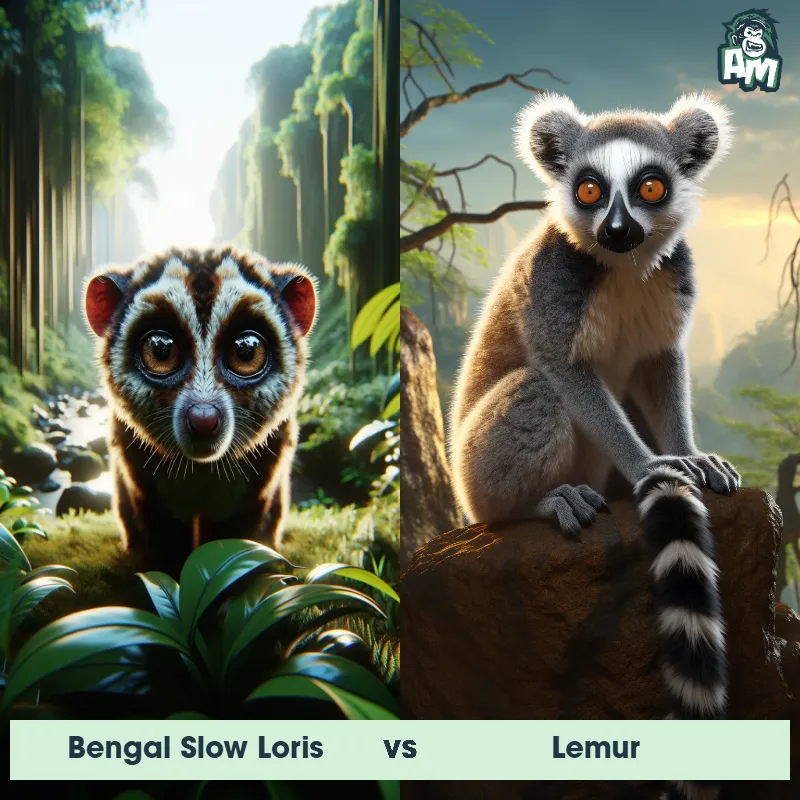The Bengal Slow Loris
The Bengal Slow Loris, also known as the Slow Loris, is a small primate species found in the forests of South and Southeast Asia. It possesses a round head, small ears, and large, round eyes that provide excellent night vision. The Bengal Slow Loris has a dense, woolly fur that ranges in color from reddish-brown to gray, with a distinctive white stripe running down its back. This species is arboreal, spending most of its life in trees, and has a slow, deliberate movement.

| Bengal Slow Loris | |
|---|---|
| Size | 6-10 inches (15-25 cm) |
| Weight | 1-2 pounds (0.5-1 kg) |
| Speed | 2mph (3.2km/h) |
| Key Strength | Strong grip and agility in trees |
| Biggest Weakness | Slow movement on the ground |
| Scientific Name | Nycticebus bengalensis |
| Family | Lorisidae |
| Habitat | Forests |
| Geography | South and Southeast Asia |
| Diet | Omnivorous, feeds on fruits, tree sap, insects, small vertebrates. |
| Lifespan | 20 years - 25 years |

The Bengal Slow Loris
The Bengal Slow Loris, also known as the Slow Loris, is a small primate species found in the forests of South and Southeast Asia. It possesses a round head, small ears, and large, round eyes that provide excellent night vision. The Bengal Slow Loris has a dense, woolly fur that ranges in color from reddish-brown to gray, with a distinctive white stripe running down its back. This species is arboreal, spending most of its life in trees, and has a slow, deliberate movement.
Fun Fact: The Bengal Slow Loris possesses a secret weapon against predators - it has the ability to produce a toxic secretion from glands located on the inside of its elbows, which it then licks and applies to its fur, creating a poisonous defense mechanism that can be lethal if ingested.
| Bengal Slow Loris | |
|---|---|
| Size | 6-10 inches (15-25 cm) |
| Weight | 1-2 pounds (0.5-1 kg) |
| Speed | 2mph (3.2km/h) |
| Key Strength | Strong grip and agility in trees |
| Biggest Weakness | Slow movement on the ground |
| Scientific Name | Nycticebus bengalensis |
| Family | Lorisidae |
| Habitat | Forests |
| Geography | South and Southeast Asia |
| Diet | Omnivorous, feeds on fruits, tree sap, insects, small vertebrates. |
| Lifespan | 20 years - 25 years |
Bengal Slow Loris Matchups
We use AI to simulate matchups between the Bengal Slow Loris and other animals. Our simulation considers size, strength, and natural predatory behaviors to determine the most likely outcome.

Can't find the Matchup you want?
Create Your Own MatchupBengal Slow Loris: Diet, Predators, Aggression, and Defensive Behaviors
What do Bengal Slow Lorises eat?
Bengal Slow Lorises are omnivores, feeding on a diet that consists of fruits, insects, small vertebrates, gums, nectar, and occasionally bird eggs. They have a slow metabolic rate, so they require a diet that is high in energy content to sustain their daily activities.
Do Bengal Slow Lorises have any predators?
Yes, Bengal Slow Lorises have several natural predators, including birds of prey, large snakes, and carnivorous mammals such as leopard cats and civets. Their nocturnal nature and cryptic coloration help them avoid detection, but they are still vulnerable to predation, especially when they are on the ground.
Are Bengal Slow Lorises aggressive?
Bengal Slow Lorises are generally non-aggressive animals and prefer to avoid confrontation. However, they may become defensive when threatened or cornered, and their bite can deliver a toxic secretion from their brachial gland, which can cause irritation or allergic reactions in humans.
Do Bengal Slow Lorises fight?
Bengal Slow Lorises are not known to engage in physical fights with other animals or members of their own species. They are solitary and territorial creatures, and their interactions with other individuals are usually limited to mating encounters or territorial disputes.
How do Bengal Slow Lorises defend themselves?
When threatened, Bengal Slow Lorises rely on various defense mechanisms to protect themselves. They can release a foul-smelling secretion from their brachial gland, which serves as a warning to potential predators. Additionally, they may curl up into a ball, hide their face with their arms, or vocalize to deter threats.
What is the biggest weakness of Bengal Slow Lorises in a fight?
The biggest weakness of Bengal Slow Lorises in a fight is their slow and deliberate movement. Despite their toxic bite and defensive mechanisms, they are not built for quick or agile physical confrontations. Their best defense strategy is to avoid conflict altogether and rely on their camouflage and secretive behavior to stay safe in their forest habitat.
Fun Fact: Bengal Slow Lorises are solitary animals that primarily communicate through vocalizations and scent-marking, using urine and secretions from their glands to mark their territory and communicate their presence to other individuals.
Fun Fact: The Bengal Slow Loris has a unique trait known as "brachiation," which allows it to swing efficiently from tree to tree using its long, slender limbs and strong fingers and toes. This skill enables the Slow Loris to effectively navigate the dense forest canopy it calls home.











